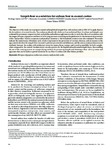Use este identificador para citar ou linkar para este item:
http://www.alice.cnptia.embrapa.br/alice/handle/doc/981621Registro completo de metadados
| Campo DC | Valor | Idioma |
|---|---|---|
| dc.contributor.author | LEITE, R. S. | pt_BR |
| dc.contributor.author | CARRÃO-PANIZZI, M. C. | pt_BR |
| dc.contributor.author | CURTI, J. M. | pt_BR |
| dc.contributor.author | DIAS, I. P. | pt_BR |
| dc.contributor.author | SEIBEL, N. F. | pt_BR |
| dc.date.accessioned | 2014-03-05T11:11:11Z | pt_BR |
| dc.date.available | 2014-03-05T11:11:11Z | pt_BR |
| dc.date.created | 2014-03-05 | pt_BR |
| dc.date.issued | 2013 | pt_BR |
| dc.identifier.citation | Food Science and Technology, Campinas, v. 33, n. 4, p. 796-800, Oct./Dec. 2013. | pt_BR |
| dc.identifier.issn | 0101-2061 | pt_BR |
| dc.identifier.uri | http://www.alice.cnptia.embrapa.br/alice/handle/doc/981621 | pt_BR |
| dc.description | The objective of this study was to prepare roasted and lyophilized tempeh flour with soybean cultivar BRS 267 to apply them in the formulation of coconut biscuits. The cookies produced with whole soy flour and mixed flour of soybean and tempeh were evaluated for proximate composition, fatty acid profile, and isoflavone aglycones in order to verify the effects of inoculation with the fungus Rhizopus oligosporus and those of the drying processes of roasting and lyophilization on the chemical characteristics of the final product. Sensory acceptance and purchase intention of the formulated products were also evaluated. The results indicate the maintenance of linolenic acid, which is important in the prevention of coronary diseases, and an increase in the aglycones levels when the tempeh flour was used. Lipids and proteins showed differences, and the sensory analyses demonstrated similarity between the cookies with satisfactory scores for aroma, flavor, texture, and overall acceptability for both samples. when compared to the control. Purchase intent was also positive for the lyophilized and toasted tempeh flours, thus enabling the use of the roasting process as a simple drying method, for processing tempeh and obtaining a flour rich in proteins and aglycones that can be used as a partial substitute for soy flour in cookies and other bakery products. | pt_BR |
| dc.language.iso | eng | eng |
| dc.rights | openAccess | eng |
| dc.subject | Rhizopus oligosporus | pt_BR |
| dc.subject | Sensory analyses | pt_BR |
| dc.subject | Alimentação humana | pt_BR |
| dc.title | Tempeh flour as a substitute for soybean flour in coconut cookies. | pt_BR |
| dc.type | Artigo de periódico | pt_BR |
| dc.date.updated | 2016-07-26T11:11:11Z | pt_BR |
| dc.subject.thesagro | Biscoito | pt_BR |
| dc.subject.thesagro | Coco | pt_BR |
| dc.subject.thesagro | Farinha | pt_BR |
| dc.subject.thesagro | Soja | pt_BR |
| dc.subject.nalthesaurus | fatty acids | pt_BR |
| dc.subject.nalthesaurus | isoflavones | pt_BR |
| riaa.ainfo.id | 981621 | pt_BR |
| riaa.ainfo.lastupdate | 2016-07-26 | pt_BR |
| dc.contributor.institution | RODRIGO SANTOS LEITE, CNPSO; MERCEDES CONCORDIA CARRAO PANIZZI, CNPT; JESSIKA MENCK CURTI, UTFPR; ISABELA PEREIRA DIAS, UTFPR; NEUSA FÁTIMA SEIBEL, UTFPR. | pt_BR |
| Aparece nas coleções: | Artigo em periódico indexado (CNPT)  | |
Arquivos associados a este item:
| Arquivo | Descrição | Tamanho | Formato | |
|---|---|---|---|---|
| 2013foodsciencetechnologyv33n4p796.pdf | 321,88 kB | Adobe PDF |  Visualizar/Abrir |









